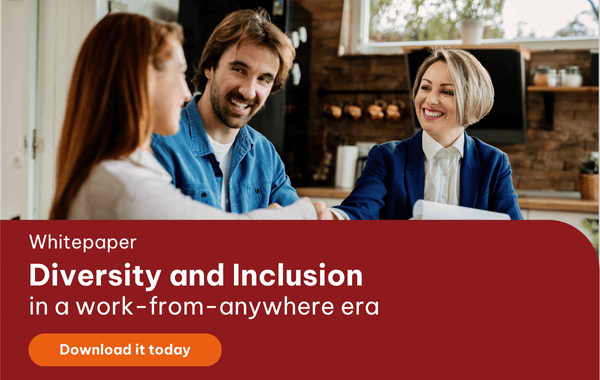Fostering diversity and inclusion in the workplace is hard enough in normal times. It’s definitely more challenging when remote working is quickly becoming the new norm even before the COVID-19 crisis. About 69 per cent of U.S. businesses now allow a flexible workplace policy, according to the 2019 IWG Workplace Survey1.
Despite the lack of real-life visual cues commonly seen in face-to-face communications, workplace diversity and inclusion are still believed to improve work efficiency, company culture, and employee engagement.

What is workplace diversity?
Usually, workplace diversity refers to a variety of diverse individuals within an organisation. Not only related to multicultural matters, but diversity also applies to differences in gender, ethnicity, age, sexuality, thought, personality, life experiences, etc.
Read more: Diversity and inclusion in the world of remote work
However, amidst the COVID-19 pandemic, the definition of diversity can also be extended to the diverse ways of working as employees are offered the flexibility to work in their preferred ways, prominently remotely.
Becoming a new normal, the trend of working from home seems to foster diversity in communications at work. Due to restrictions in real-life communications and interactions, working remotely allows people to access a wider range of support tools. For instance, Zoom and Microsoft Teams, benefiting not only employees but also help the Human Resources team to gain the opportunity to expand diversity hiring across the board.
Why is workplace diversity important?
Workplace diversity hugely benefits business culture and performance. It enables companies to access a broader range of talents, whose world-views are diverse and positively contribute to the company's insights on a variety of subjects. Workplace diversity - that is to say, embraces different perspectives and leads to higher creativity and innovations.
Furthermore, workplace diversity promotes inclusion, hence, making employees feel welcomed and included, which helps boost employee engagement and lower turnover rates.
What is workplace inclusion?
Inclusion regards the extent to which diverse individuals truly feel a sense of belonging. Indications of workplace inclusion are the ability to express their opinions or participate in the decision-making processes freely.
Benefits of workplace inclusion
Inclusion is the key attribute that supports diversity to create a model working environment and hence, being an ideology for organisations. According to Achievers2, without an influential practice of inclusion, organisations, including distinct individuals, may not perform well.
Also, the more the employees feel they are included, the higher the morale they gain. The sense of belonging, as a result, can enable businesses to obtain positive performance results, thus, enhancing collaboration and employee engagement.
Read more: Employee engagement matters, but why?
Impacts of working from home on workplace diversity and inclusion
Although workplace diversity and inclusion exist under the new model of working from home, it still creates challenges in developing and maintaining company culture as well as building relationships. Fortune3 said that long distances highly promote people’s bias to favour people who are similar to them while reducing the chance for spontaneous communication between different people who may be around.
Moreover, some employees may have unequal access to opportunities and resources or essential tools for doing the jobs from home, such as a stable Internet connection, or specific software, which creates differences that make it harder for them to feel included.
On the flip side, Harvard Business Review believed that working from home gives companies an advantage in retaining talented, especially highly motivated employees4.
Ways to promote workplace diversity and inclusion
Creating an inclusive and diverse environment within an organisation revolves around the art of effective communication. Employees have to be proactive to engage in the team. Since working from home limits the opportunities for face-to-face communication, it fosters the use of telecommunications.
Here at TRG International, we have a multitude of interns and staff who work remotely from different places in the world. To create a dynamic and inclusive environment for such a diversity of people, we try to implement regular check-in calls, motivate them to raise questions, and ask for feedback as well as cultivate knowledge via our online learning platforms.
Below are some ways to increase diversity and inclusion in the virtual workplace.
Encourage diverse thinking
Having employees of different backgrounds allows a company to think in culturally diverse ways. However, it is mandatory that the means of sorting the ideas and issues be in unity.
People must be aware of others' perspectives towards the issues that are in discussion, and by welcoming different viewpoints, the company will have more fresh ideas while at the same time, creating an environment where everyone feels connected and encouraged to contribute to the shared mission.
Create opportunities for relationship development
In a remote work environment, showing care to others is a bit more challenging as there are few chances for in-person social interactions. However, the substitute for a morning greeting in real life is an online gathering with the whole team where everyone can build connections and bond with each other.
In this way, people should also be encouraged to share and reflect on others' needs and expectations, which in turn, clear out possible confusion and strengthen work relationships and performances.
Give recognition
Praises and good words are essential for promoting one-to-one relationships. Acknowledging employees' hard work with proper rewards can boost office culture and a sense of belongingness.
Everyone’s input should be considered valuable in different yet equally important ways, hence, needs to be acknowledged regardless of working circumstances. Suggestions for recognition in remote working are commendations via a personal email or a shout-out during an online meeting.
References:
1. http://assets.regus.com/pdfs/iwg-workplace-survey/iwg-workplace-survey-2019.pdf
3. https://fortune.com/2020/05/24/remote-work-diversity-inclusion-challenges/
4. https://hbr.org/1998/05/the-alternative-workplace-changing-where-and-how-people-work
 English
English  Vietnamese
Vietnamese 


